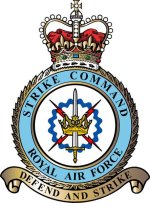
The Royal Air Force's Strike Command was the military formation which controlled the majority of the United Kingdom's bomber and fighter aircraft from 1968 until 2007 when it merged with Personnel and Training Command to form the single Air Command. It latterly consisted of two formations – No. 1 Group RAF and No. 2 Group RAF. The last Commander-in-Chief was Air Chief Marshal Sir Joe French.

The RAF Second Tactical Air Force (2TAF) was one of three tactical air forces within the Royal Air Force (RAF) during and after the Second World War. It was made up of squadrons and personnel from the RAF, other British Commonwealth air forces, and exiles from German-occupied Europe. Renamed as British Air Forces of Occupation in 1945, 2TAF was recreated in 1951 and became Royal Air Force Germany in 1959.
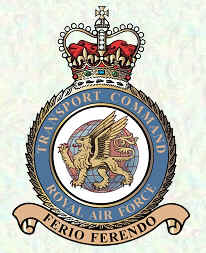
RAF Transport Command was a Royal Air Force command that controlled all transport aircraft of the RAF. It was established on 25 March 1943 by the renaming of the RAF Ferry Command, and was subsequently renamed RAF Air Support Command in 1967.

RAF Brampton was a non-flying Royal Air Force installation near Huntingdon in Cambridgeshire, England. Formerly the home of RAF Support Command, it also became the home of several elements of Defence Equipment & Support (DE&S), which itself was a result of a merger between the Defence Logistics Organisation (DLO) and the Defence Procurement Agency (DPA), and provided a base for the Defence Security & Assurance Services and Defence Estates.

The Royal Air Force Police (RAFP) is the service police branch of the Royal Air Force, headed by the provost marshal of the Royal Air Force. Its headquarters are at RAF Honington and it deploys throughout the world to support RAF and UK defence missions.

Personnel and Training Command (PTC) was one of two commands of the Royal Air Force that were merged to form Air Command on 1 April 2007.
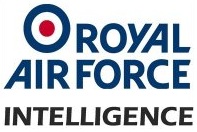
Intelligence services in the Royal Air Force are delivered by Officers of the Royal Air Force Intelligence Branch and Airmen from the Intelligence Analyst Trade and Intelligence Analyst (Voice) Trade. The specialisation has around 1,200 personnel of all ranks posted to operational air stations, HQs and other establishments of the British Armed Forces, both in the United Kingdom and overseas.

No. 1 School of Technical Training is the Royal Air Force's aircraft engineering school. It was based at RAF Halton from 1919 to 1993, as the Home of the Aircraft Apprentice scheme. The Aircraft Apprentice scheme trained young men in the mechanical trades for aircraft maintenance, the graduates of which were the best trained technicians in the RAF and would usually progress to Senior NCO ranks. However, ninety one ex-apprentices went on to achieve Air Rank. Many more became commissioned officers, including Sir Frank Whittle "father of the jet engine", who completed his apprenticeship at RAF Cranwell, before the move to RAF Halton. Graduates of the Aircraft Apprentice scheme at RAF Halton are known as Old Haltonians.

Marshal of the Royal Air Force Sir Thomas Geoffrey Pike, was a senior officer in the Royal Air Force. He served in the Second World War as a night fighter squadron commander and then as a station commander. He was Chief of the Air Staff in the early 1960s and, in that role, deployed British air power as part of the British response to the Brunei Revolt. Also, in the face of escalating costs, he implemented the cancellation of the British Blue Streak ballistic missile system but then found the RAF was without any such capability when the Americans cancelled their own Skybolt ballistic missile system. He went on to be Deputy Supreme Commander Supreme Headquarters Allied Powers Europe in the mid-1960s.
Air Chief Marshal Sir John Gingell, was a senior Royal Air Force commander and Gentleman usher of the Black Rod.

The Air Member for Personnel (AMP) is the senior Royal Air Force officer who is responsible for personnel matters and is a member of the Air Force Board. The AMP is in charge of all aspects of recruiting, non-operational flying and ground training, career management, welfare, terms, and conditions of service, and resettlement for RAF regular, reserve, and civilian staffs worldwide.

No. 22 Group Royal Air Force is one of six groups currently active in the Royal Air Force (RAF), falling under the responsibility of Deputy Commander-in-Chief (Personnel) in Air Command. Its previous title up until 2018 was No. 22 (Training) Group. The group is responsible for RAF training policy and controlling the Royal Air Force College and the RAF's training stations. As such, it is the direct successor to Training Group. 22 Group provides training to all three service branches of the British Armed Forces; namely the Royal Air Force, the Royal Navy, and the British Army.

Air Chief Marshal Sir Charles Stuart Burnett, was a senior commander in the Royal Air Force during the first half of the 20th century. He was Air Officer Commanding Iraq Command during the early 1930s. During the Second World War, he served as Chief of the Air Staff of the Royal Australian Air Force.

Flying Training Command was an organization of the Royal Air Force; it controlled flight training units. The command's headquarters were at RAF Shinfield Park, Reading in Berkshire.
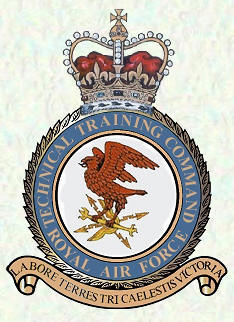
Technical Training Command was an organization within the Royal Air Force which controlled units responsible for delivering aircraft maintenance training and other non-flying training, initially in Berkshire and then in Cambridgeshire.
Air Vice Marshal Peter John Harding, was a senior Royal Air Force officer who served as Defence Services Secretary from 1994 to 1998.
Royal Air Force Harrogate or RAF Harrogate, sometimes known as Ministry of Defence (MoD) Harrogate, was the name for two distinct Royal Air Force establishments within the town of Harrogate, North Yorkshire, England. The main site was at St George's in the south-west of the town and was home to a medical training establishment (MTE), supply branch and Women's Auxiliary Air Force (WAAF) training centre. The site was demolished in 1994. The term RAF Harrogate was also applied to the requisition of several hotels in Harrogate town centre which acted as a No. 7 Personnel Reception Centre during World War II. This should not be confused with RAF Menwith Hill, a current RAF base near Harrogate.
At the end of the Cold War in 1989, the Royal Air Force (RAF) structure was as follows:

No. 23 Group RAF was a group of the Royal Air Force, first established in 1918. It disbanded the same year but reformed during 1926 and finally disbanded for the second time in 1975.
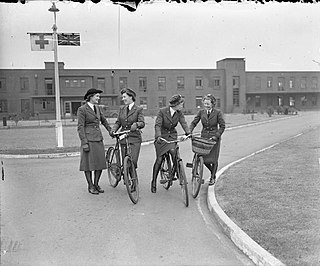
RAF Hospital Ely, was a Royal Air Force staffed military hospital in Ely, Cambridgeshire, England. The hospital opened in 1940, and was one of a handful of Second World War era RAF hospitals that were kept open post Second World War, remaining a military asset until 1992, although it also treated non-service patients, usually those who lived locally. On closure, the hospital became a civilian hospital under the NHS. Although not located on an established RAF Base, RAFH Ely was located within 50 miles (80 km) of forty RAF bases in the Second World War.















